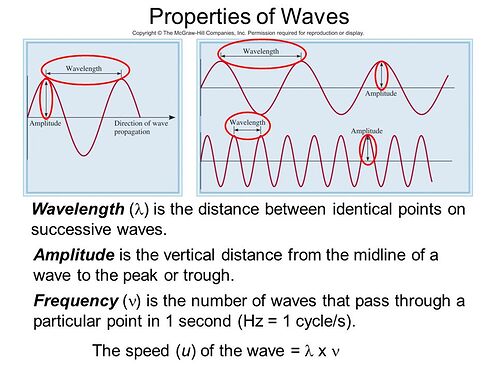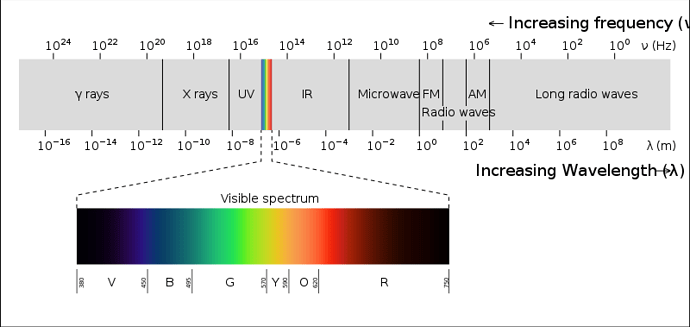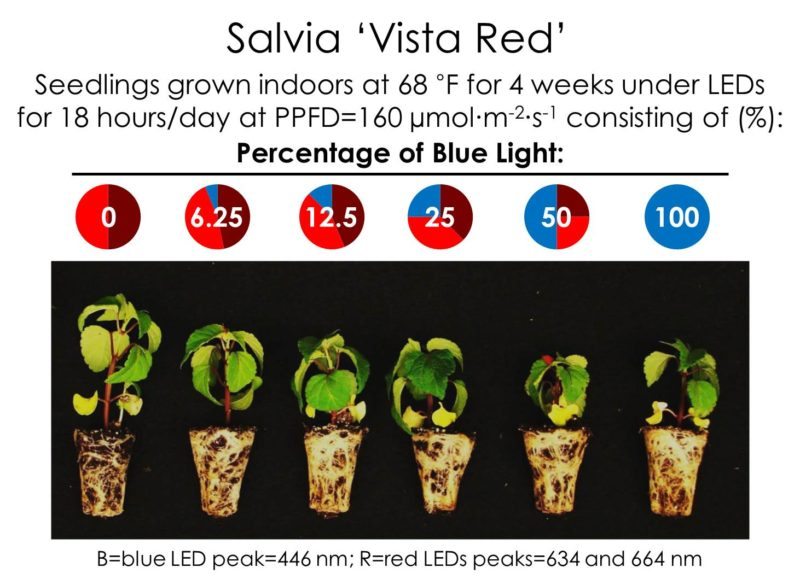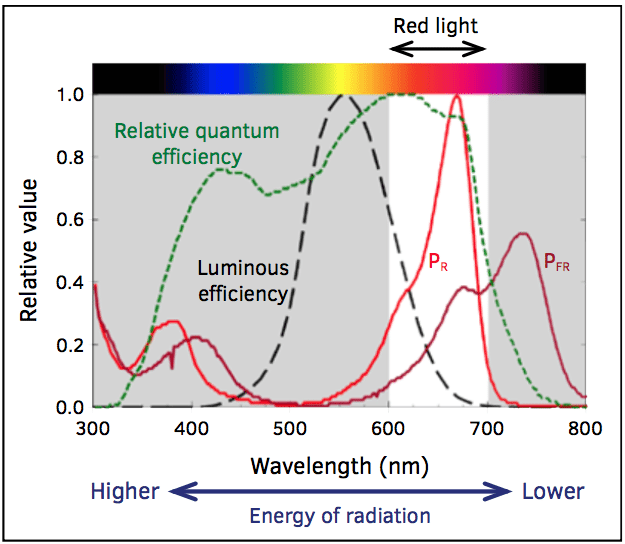LED’s - Wavelengths [RED + BLUE]Growing Guides - 101#growing-help
Effects of different Wavelengths ( in Each Stage - Seedling, Vegative & Flowering )
What are Wavelengths?
A wavelength is the horizontal distance between the two peaks of the wave. Light is measured by its wavelength (in nanometers). It is usually characterized by the Greek symbol λ.
Visible light is usually defined as having wavelengths in the range of 400–700 nanometers (nm) or one billionth of a meter.
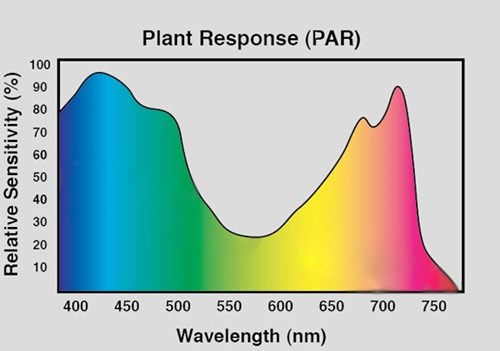
Visible light is usually defined as having wavelengths in the range of 400–700 nanometers (nm) or one billionth of a meter.
EM waves are categorized according to their wavelengths and frequencies (number of waves passing a point in a certain time). This classification determines if the electromagnetic radiation sits to the left or right of the Visible spectrum.
Light is energy that will take on different forms.
The image below details the electromagnetic spectrum with light highlighted. (Noted as Visible spectrum)
Here’s what I mean…
EM Spectrum Img 

Wavelength Table
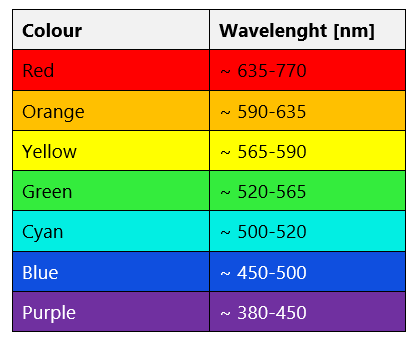
BLUE LIGHT AND PLANT GROWTH
Seedling | Vegging
Blue light is usually referred to as radiation with wavelengths
between 400 and 500 nm. This waveband is within the visible
spectrum, has relatively high energy, and has pronounced
effects on plant growth and flowering. Our perception
of blue light, especially at shorter wavelengths (for
example, 400 to 425 nm) is low compared to green
light. In contrast, blue light is considered equally
effective as green or red light at driving photosynthesis.
Thus, while blue light can appear somewhat dim to
us, it has high energy and is useful for plant growth
applications.
Blue photons drive the photosynthetic reaction,
although from an energy standpoint, one might consider
them less efficient than green or red photons because
their high energy isn’t fully utilized; some of the energy
is essentially lost compared to photosynthetic photons
with a longer (less energetic) wavelength. However, at
least a minimal intensity of blue light is needed in sole-source
(indoor) lighting applications for normal plant growth. In
addition, blue light regulates the opening of stomata, which are
the tiny openings on leaves that control both water loss and the
uptake of carbon dioxide. Generally, only a low intensity of blue
is needed in a light spectrum for fully functional photosynthesis.
Therefore, indoor lighting (such as in vertical farming) and
greenhouse lighting usually include blue in the spectrum.
Generally, blue light suppresses extension growth; plants
grown with blue light are usually shorter and have smaller,
thicker and darker green leaves compared to plants grown
without blue light
these attributes can be desirable because in essence, blue
light can act as a growth regulator. The utility of blue light
as a growth regulator is pronounced with indoor lighting
and generally has less or no growth-inhibiting effects in
supplemental greenhouse lighting. There are some reports in
which extension growth is actually promoted under only blue
light, although this response seems to be crop specific.
Radiation with shorter wavelengths (blue/UV) stimulates the
production of compounds that can influence leaf coloration.
For example, in the absence of blue/UV radiation, plants that
have purplish leaves outdoors may have green leaves. In some
leafy greens crops such as lettuce, blue/UV also increases
the production of healthful compounds such as antioxidants
and some vitamins. Thus for these crops, delivery of blue/UV
radiation prior to marketing can increase crop quality attributes
such as leaf coloration and nutrition. Similarly, in the absence of
blue/UV, some plants in the tomato (nightshade) family develop
intumescences, or small blisters, on leaves, stems and petioles.
This physiological disorder typically decreases as blue/UV
radiation increases.
BLUE LIGHT AND FLOWERING
Flowering | Blooming + Effects of Wavelength]
At a low intensity, such as that typically used to deliver
photoperiodic lighting (1-2 µmol∙m–2∙s–1), blue light does not
regulate flowering of most daylength-sensitive crops. However,
at a higher intensity (such as 20 µmol∙m–2∙s–1 or higher), blue
light can promote flowering of long-day plants and inhibit
flowering of short-day plants. In recent research at Michigan
State University, we delivered moderate intensities of blue
light in our greenhouses in an attempt to regulate flowering
and suppress extension growth. While we were successful
at regulating flowering, there was no consistent effect on
suppressing plant height.
Blue LEDs have become very efficient and inexpensive because
they are used to create white LEDs for human applications.
However, because of the high energy of light emitted from blue
LEDs, and because the blue light appears relatively dim to us,
people should never look directly at blue LEDs without UV/blueblocking safety glasses.
technically speaking
Figure 1. Seedlings grown indoors with blue light are often shorter, and
have smaller leaves, than those grown under only red light. Plants were
grown at the same photosynthetic photon flux density (PPFD) in an
environmental growth chamber. Research from Heidi Lindberg and Erik
Runkle, MSU.
RED LIGHT AND PLANT GROWTH
When you hear the term “red light,” what do you think of? Stopping at a traffic light? A certain district in Amsterdam? Light from LEDs? Red light can convey caution or danger or stopping at intersections, but for plants red light is highly effective at regulating growth and development. Within the photosynthetically active waveband (400 to 700 nm), sunlight emits roughly similar amounts of blue, green and red light. With conventional electric lamps, the proportion of light is
somewhat similar, ranging from 24 percent for cool- white fluorescent to 40 percent for high-pressure sodium (HPS) lamps.
With arrays of light-emitting diodes (LEDs), the proportion of red light can range from 0 to 100 percent. Many commercial LED fixtures developed for plant growth applications emit a large proportion of red light, with 75 to 85 percent of the light spectrum commonly emitted in the red region.
Figure 1. Red light is usually defined as radiation with wavelengths between 600 and 700 nm. Although red light has a low luminous efficiency, meaning that the light appears relatively dim to people, it has a high relative quantum efficiency and is highly absorbed by the red-absorbing (PR) form of phytochrome. Therefore, at least with LEDs, red light is often the primary waveband used for photosynthetic and photoperiodic lighting.
The primary reasons why LED fixtures emit more Red Wavelengths.
1) Red LEDs are among the most efficient at converting electricity into photosynthetic photons.
2) Chlorophyll strongly absorbs red light, thus it is effective at photosynthesis
3)They are relatively inexpensive. Let’s take a brief look at how red light influences plant growth and development**
The “brightness” of red .
The luminous efficiency curve illustrates our visual perception of the brightness of different colors of light under well-lit conditions. At the same intensity, green and yellow light appear bright to us while red appears dim. A common type of red LED has an emission peak at 660 nm, which has a relative visual efficiency of less than 10 percent.
Red light on photosynthesis.
The relative quantum efficiency curve (Figure 1) generated by Keith McCree more than 40 years ago quantifies the efficiency of different colors of light at stimulating photosynthesis on an instantaneous basis. Although this curve is sometimes over-interpreted, it does show that red light is at least as effective as other colors of light at promoting plant growth. Therefore, while red light isn’t the most efficient color for general illumination for people, it is among the best colors of light to stimulate plant growth.
Many plants grown under only red light, such as plants grown indoors under only red LEDs, have a stretched, elongated appearance; the leaves are thin and large and plants become tall. In most cases, plants grown under only red light do not have desirable growth characteristics. However, when a relatively small amount of blue light is added to red light, extension growth of plants is inhibited. Therefore, plants grown indoors with 80 to 90 percent red light and 10 to 20 percent blue light are quite compact, with smaller leaves and shorter stems. In greenhouses, plants receive the wide solar spectrum and so the color of light provided by supplemental lighting has much less impact on extension growth.
As discussed in previous articles, the amount of red light relative to the amount of far-red radiation (R:FR) also has a pronounced effect on leaf expansion and stem elongation. As far-red is added to red light, the R:FR decreases and extension growth increases. High-pressure sodium and fluorescent lamps emit a high R:FR while sunlight and incandescent lamps emit a low R:FR. In greenhouses, extension growth can be slightly inhibited using lamps with a low R:FR, or no far red as is the case for many LEDs. Indoors, the absence of far red in a light spectrum results in compact growth.
Red light on floweringFlowering | Blooming + Effects of Wavelength
The pigment phytochrome mediates flowering of plants with a photoperiodic flowering response. Generally, plants are very sensitive to low intensities of red light; during the night, 1 μmol∙m–2∙s–1 of red light can inhibit flowering of short-day plants and promote flowering of some long-day plants because of phytochrome’s sensitivity to red light (Figure 1). The addition of far-red radiation to red light, in roughly similar quantities, is effective to stimulating flowering of a wide range of long-day plants. Therefore, lamps designed to regulate flowering of plants always emit red light and in some cases, also far red.
- Yes
- 50/50
- No
0 voters
#question What did you want to know?
